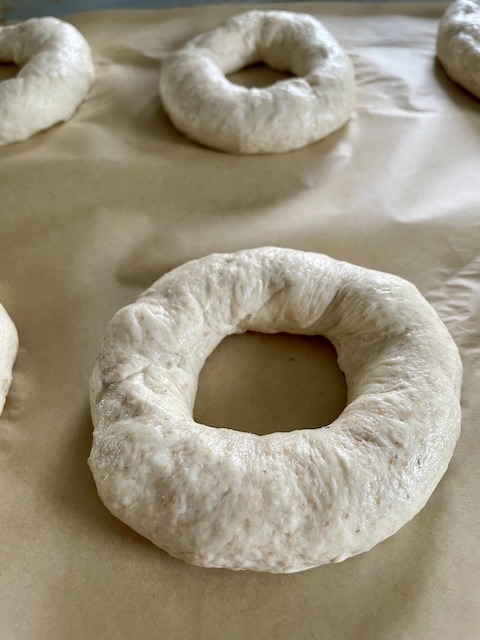Sourdough bagels are delicious and so easy to make at home.

There is nothing like biting into a fresh bagel still warm from the oven. This bagel recipe is designed with flexibility in mind. Make the dough and shape the day before, and all you have to do in the morning is boil and bake. The crunchy crust contrasts with the chewy center, making for a majorly satisfying bite. Smeared with cream cheese or butter, is there anything better?
- What equipment do you need to make these overnight sourdough bagels?
- Ingredients and baker's percentage for sourdough bagels
- Suggested proofing and baking schedule
- Shaping the bagels
- Boiling the bagels
- The importance of oven temperature
What do you need to make these overnight sourdough bagels?
Equipment wise, there is not much you need to make these bagels:
- I use my KitchenAid to mix my bagel dough. If you do not have a stand mixer, you can mix the dough by hand in a bowl or on the countertop. I find that because of the low hydration level of the dough, the dough may be on the stiffer side and require some elbow grease.
- You will need a pot to boil the bagels and a wire strainer or some other tool to lift the bagels from the boiling water.
- The bagels are baked on a baking tray, parchment paper is optional.
Ingredients and baker’s percentage for sourdough bagels
The ingredients are super simple: in the dough there is only flour, sugar, water, and salt. Some bagel recipes call for malt syrup which improves the flavor of the bagels. For this recipe, I wanted to focus on ease and accessibility so I opted not to use malt syrup because (1) it is not the most common ingredient to find; and (2) it is not essential to a good bagel (~in fact, I have been unimpressed with malt syrup so far).
| Weight (Grams) | Ingredients | Baker’s Percentage |
|---|---|---|
| 60 | Sourdough starter | 15% |
| 25 | Sugar | 6.25% |
| 200 | Water | 50% |
| 400 | Flour | 100% |
| 3.5 | Salt | 0.875% |
Hydration level of this dough is roughly 53% (since the starter is comprised of 30g water and 30g flour, we can calculate the hydration by dividing the total weight of the water (230g) by the total weight of the flour (430g)).
Suggested proofing and baking schedule
While bagels can be made and enjoyed any time of day, the following schedule times the bagels to be ready the next morning – just in time for breakfast!
- Early afternoon, around 2 pm: Mix the dough and bulk ferment at room temperature.
- Sometime in the evening, around 8 or 9 pm: Shape the bagels, and retard the shaped bagels in the fridge overnight.
- Next day, morning – one hour before you want bagels: Preheat oven, boil bagels, and bake.
As you can see, the above schedule is quite loosey-goosey, as should be the way with bread-making. There are many variables which may affect when fermentation is ready such as the strength of your starter and the ambient temperature of the room. Luckily, bagels are one of the most forgiving breads to make, and sourdough, which rises slower than commercial yeast, makes this bagel recipe even more forgiving.
If you started making bagels and then find that you have no time or effort to bake them the next morning, that is fine. I have found myself in the same situation. Bagel dough can chill out in the fridge for a long time. In fact, the bagels pictured below were left to bulk ferment in the fridge for 2 days. I made the dough at 2 pm, but instead of shaping and retarding overnight, I chucked the entire dough into the fridge around 9pm. When I was ready to boil and bake (2 days after I made the dough), I preheated the oven and boiled my pot of water, I shaped the bagels and boiled them almost immediately (i.e. without letting them rise more).


Flavor-wise, the two-day bagels were still very good. Perhaps even better if you prefer the taste of sourdough. The bagels which were left in the fridge for 2 days were noticeably more flavorful and sour than the bagels which were only left to retard overnight. As you can see, they also had more aeration with bigger holes. If I had to choose, I would prefer the bagels made with the overnight method because of flavor (personally, I don’t want my bagels to be too sour), but to each their own.
If you want bagels as fast as possible, you don’t even need to ferment the dough overnight. To speed up fermentation, lower the salt content or omit the salt entirely. In fact, did you know that authentic Montreal style bagels have no salt and are processed continuously without lengthy proofing?
The point being, bread making should never be a strict process and should always work with your schedule. With the magic of salt and refrigeration (both of which slows down fermentation), baking can be delayed. With knowledge of these factors you can have bagels the same day (no salt, warm ambient temperature, leading to a quick rise) or many days later (salt, cold fermentation, leading to a slow rise). You are the one in control.
Shaping the bagels
There are two ways of shaping bagels. The first method is to roll the dough into a long coil and then to roll the ends together into a “O” shape. The second method is to roll your pre-divided dough into a ball, poke a hole through the middle, and then thin out the dough by widening the hole. Personally, I find the second method to be more efficient.

Unlike sourdough loaves, bagels do not need to rest for long after shaping. Depending on your schedule, the bagels can either be boiled right after shaping, or left to retard overnight in the fridge.
Do not leave the shaped bagels for long on the counter or other surface (such as parchment) because they may stick and be difficult to remove. For the same reason, make sure that the shaped bagels do not touch each other. Transfer the bagels directly onto a tray (if retarding overnight) or into the water (if boiling immediately). There is no need to grease or flour the tray because bagels will be easy to remove after refrigeration.
Boiling the bagels
Bagels are boiled before baking. Some bakers boil bagels in a solution of baking soda, brown sugar, or honey (or maple syrup to make it vegan). These ingredients add flavor and color to the crust. However, these are totally optional ingredients! I have tested boiling bagels in a weak solution of baking soda, a solution of water and maltose, and only water. In my opinion, while boiling in a slightly alkaline solution does add color (in the same way that a pretzel is made by soaking in a low ph solution before baking), the biggest factor is oven temperature. Personally, I did not notice a difference between the bagels that were boiled in water and those boiled in water + maltose.

Bagels should not be boiled for more than one minute. Some recipes call for boiling until the bagel floats – however, this is not a good indicator of readiness as a dense bagel that has not been proofed for a long time may never float! This article explains the science of boiling bagels. Because I want a puffy bagel, I boil until the outside gelatinizes and not much longer than that (regardless of whether the bagel floats or not!) – around 30-60 seconds.
Let’s talk about oven temperature
Oven temperature is the biggest factor in achieving a bagel with a crunchy crust. The famous bagel shops in Montreal bake their bagels in a wood-fired oven, which gets much hotter than what a home oven can achieve. So how hot should your oven be when baking bagels? Depending on how your bagels are boiled and your oven situation, this could be anywhere between 425 F and 500 F. If you want a crunchy, golden-brown crust, I would say (with caution) to go as hot as your oven can handle without burning anything or setting off the fire alarm.
For my gas oven, the ideal temperature is around 450 F. If you have a convection setting, the circulating air may help with heat distribution. If you have a pizza stone or a baking stone, that will definitely help as well.


Troubleshooting the baking process
The fire alarm goes off.
- This is the most common problem in our house! Our fire alarm goes off almost anytime my oven heats above 450 F, even when nothing seems to be burning. If this is the case for you – that nothing is burning – then the solution may be to lower your oven temp. Unfortunately, less heat means less nice of a crust. To counteract the paleness, boil bagels in a slightly basic solution (i.e. with some baking soda).
- If you are topping your bagels with seeds, sometimes bits of burning seeds may produce enough smoke to set off the fire alarm. Not much to be done here except to make plain bagels instead, or to clean up any stray seeds from the baking tray as best as you can before putting into the oven.
The bottom of the bagels are burnt.
- There are two potential causes for this. First, your bagels could be too close to the bottom heat source, in which case is easily fixed by moving to a higher rack.
- The second potential cause has to do with the conductivity of your baking tray. Baking trays come in all sorts of sizes and materials, and some materials may heat up faster than others. Switching to a light-colored or thicker baking tray may solve the problem. You could also try using parchment paper or a silicon baking mat. However, some of these materials cannot withstand high heat. For instance, the parchment paper that I use has a warning that the product should not be used in ovens above 425F. Another thing to check for is that the baking tray does not touch the sides of the oven, which may lead to overheating of the tray. Finally, if you have multiple baking trays you can stack, stacking two trays together may help prevent bottom burning.
The bagels are unevenly colored.
- This may happen if your oven has hot spots. Rotate the pans halfway through baking to counteract this.
- Overcrowded bagels may not brown evenly. To avoid this, make sure that your bagels are not touching each other and that the bagels have some room to expand before going into the oven.
Easy Overnight Sourdough Bagels
Ingredients
For the dough
- 60 g sourdough starter (fed and ready to be used)
- 25 g sugar
- 200 g water
- 400 g flour
- 3.5 g salt
For the boiling liquid
- 4 cups water or more, depending on the size of your pot
- 2 tsp baking soda (optional) increase if using more water
Optional toppings
- your favorite bagel toppings – enough to cover a plate
Instructions
- 2 pm: Make the dough by combining all the ingredients under the dough subheading. Mix with a stand mixer or by hand until dough is smooth and pliable. Allow dough to rest for 3-7 hours.
- Evening (8 or 9 pm): Divide the dough into 8 equal parts. Shape the bagels by poking a hole and rolling outwards, or by rolling the divided though into a rope and then rolling the ends together in a loop. Set the bagels on a tray (taking care that they do not touch each other), cover with plastic wrap or other material and place in fridge overnight.
- Next morning: Preheat the oven to 450 F. Boil water (and if using, baking soda) in a pot.
- If you are topping the bagels, pile the toppings on a plate. The more there are, the easier they will stick to the bagels.
- Once water has boiled, drop as many bagels as will fit in the pot without crowding, taking care that they do not stick to the bottom of the pot (gently dislodge and stir with a spatula if they do). Boil each bagel for 30-60 seconds, and remove with a wire strainer or other tool.
- If you are topping the bagels, press the bagels into the toppings (on all sides, if desired) after removing the bagels from the boiling water, while the bagels are still warm and damp.
- Transfer the bagels onto a baking tray and bake for 20-25 minutes, or until golden brown.
Video
@hellenshouse Bagels are so easy to make and my overnight sourdough bagel recipe makes it even simpler. Make the dough the day before and the next morning the bagels and ready to be boiled, baked, and CRUNCHED up. 🔗https://hellenshouse.com/easy-overnight-sourdough-bagels-vegan/ 🎵 sunday by HNNY #veganbaking #homemadebagels #sourdoughbagels #sourdoughbread #sourdoughbaking #sourdoughtok #bakingtutorial
♬ Sunday – HNNY
Subscribe to my newsletter
(Sporadic) updates on new posts and recipes sent straight to your inbox.

Leave a Reply